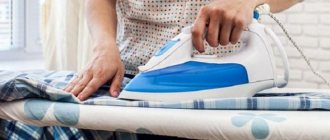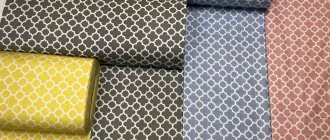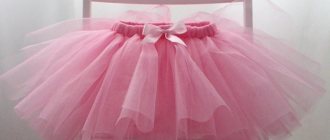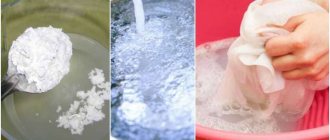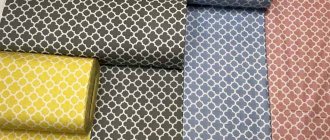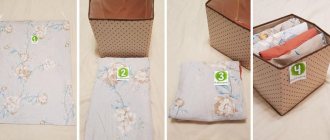Ironing is one of the least favorite activities of any housewife. This is especially true for bulky and heavy bedding.
Ironing it is sometimes a real torture, especially if there are several sets waiting in line.
From this article you will learn: is it necessary to iron bed linen after washing, is it necessary in principle, what is better to use - an iron or a steamer?
You will also find useful tips regarding the correct ironing, folding and storage of bedding sets, depending on their composition.
Do I need to iron my bed linen?
Ironing bed linen immediately after washing is not strictly necessary. This is just a tip that will help you iron bulky bedding with less effort.
In any case, after washing, you need to let the fabric dry a little ; there is no point in ironing completely wet bed linen.
If you don’t have time to wait for it to become wet, it doesn’t matter. Dried items should be carefully folded and left to wait their turn for ironing. Subsequently, before ironing, the fabric will still have to be slightly moistened, for example, from a spray bottle.
Rules for storing ironed linen
To store clean linen, you need to allocate a spacious drawer where bedding will be placed freely without squeezing each other. If you had to use steaming or additional moisturizing during ironing, you need to wait a while for the textiles to completely dry, and only then put the items in their storage place.
It is advisable not to use freshly ironed linen, but to let it rest for at least a few days. This will significantly increase the wear resistance of the material. In addition, to avoid premature damage to the fabric, when folding sheets and pillowcases after ironing, you need to change the fold location. You can place bags of fragrant dried herbs between the piles of laundry, then the bed will always smell pleasant.
Ironing clothes won't seem like a boring task if you combine the work with watching TV shows or listening to an audiobook.
Why do you need to iron?
The answer to this question should be sought in two categories:
- Medical - in other words, ironing is good for health. Exposure to high temperatures will help get rid of harmful microorganisms (bed mite larvae, bacteria and microbes) remaining on the fabric even after washing. This is especially true for allergy sufferers and people with reduced immunity.
- Aesthetically , it is much more pleasant to lie down in a clean, fresh-smelling and ironed bed. It is not only softer and more pleasant to the touch, but also promotes healthy sleep. Even the most ardent opponents of ironing will not refuse to lie in such a bed.
Lavender water for laundry
And after all, who doesn't love the fresh lavender scent of their laundry? Spray your damp sheets with a special lavender spray - the heat of the iron will transfer the fresh aroma to the fabric. Try using lightly scented lavender water to help you achieve a good night's sleep. There are many good products on the market and below you will find a spray recipe if you prefer to mix your own.
Pour 2.5 tbsp into a spray bottle. distilled or mineral water (not tap water, which contains chlorine), 1 tsp. high quality lavender essential oil and 1/8 tbsp. vodka. Stir well and use. You may want to mix this water separately for each ironing session because the liquid may become cloudy, which is normal. Vodka acts both as a preservative and an emulsifier. When purchasing vodka for this purpose, choose the highest quality possible, but do not buy products from expensive brands.
Now you have the complete recipe for creating a luxurious ironing experience for your lovely bed linens.
Why and in what cases is it not necessary?
Opponents of ironing bed linen (and not only it) argue that it is a waste of time. They have compelling arguments for this:
firstly , they consider ironing a relic of the past;- secondly , it takes a huge amount of time and effort, especially if you need to iron several sets of bed linen;
- thirdly , the smoothness of the fabric remains only for a few nights, and after a couple of days you will no longer be able to distinguish the previously ironed linen from the one that was not ironed at all.
If this is not enough, then there are also the following arguments:
- some materials become electrified after ironing (synthetics, especially polycotton, i.e. a mixture of polyester and cotton in various proportions);
- You may notice that after ironing the fabric absorbs moisture less well. This will not appeal to those who sweat a lot during sleep;
- The aroma from fabric softener disappears when exposed to high temperatures.
You will find 3 arguments against ironing bed linen here.
When is ironing necessary?
Situations in which it is impossible to refuse to use an iron:
- one of the family members has a contagious disease in the acute stage. It is especially important to carry out disinfection in the presence of skin diseases: fungus and lichen. However, even ironing at high temperature in this case is not enough and it is recommended to allocate a personal set of bed linen for the patient;
- bedding is intended for a newborn. It is possible to refuse ironing after the umbilical wound has completely healed. Over time, it will be enough to wash your baby’s clothes at 90 degrees in a washing machine.
How to iron on an ironing board?
When ironing a sheet with corners, iron the sides first. Then roll them inward. Fold the resulting rectangle into four times. Then iron thoroughly on all sides.
Experts recommend ironing along the grain, i.e. the warp thread that runs along the fabric. Therefore, you need to move the iron across the fabric from left to right (or vice versa), and not up and down.
Step-by-step ironing instructions:
Prepare your work area (it may be more convenient for you to iron on a table rather than on an ironing board).
In any case, bedding, with the exception of pillowcases, will need to be folded. Their size should correspond to the surface on which you will iron.- Straighten out all folds and folds, regardless of whether the laundry is wet or dry. If it is dry, sprinkle it with water and give the water a little time to absorb.
- First, it is recommended to straighten and iron the seams. This will prevent deformation of the entire product during the further ironing process.
- If you want to get the perfect effect of smoothness of the fabric, unfold the product and fold it again with the unironed sides on top. Align the fold lines so that they do not “run away”.
- It is advisable to fold the duvet cover and sheet into four after the main ironing. Iron each side again. Ready!
Temperature recommendations
The temperature regime that must be selected for ironing bed linen directly depends on the composition of the fabric. Always check the label for the ingredients of the product.
Remember that by checking the material only “by eye” you can very easily make a mistake, because some of them are very similar to the touch. Incorrectly set iron temperature can ruin the appearance of your bed linen.
The table below shows the most popular fabrics from which bed linen is made and the appropriate ironing temperature.
The right column serves as a hint in what state - wet or dry - it is most comfortable and easy to iron each material:
| Material | Acceptable ironing temperature (оС) | Fabric condition |
| Pure cotton | 140-180 | Slightly damp |
| Cotton with polyester added | 90-120 | Slightly damp |
| Linen | 180-200 | Heavily moisturized |
| Cotton with linen | 160-180 | Moisturized |
| Satin | Up to 180 | Dry |
| Chintz | 150-170 | Moisturized |
| Jacquard | Maximum 110 | Slightly damp |
Bed linen made from fabrics such as silk, calico, satin practically does not need ironing . If you still want to iron clothes with this composition, do it at the lowest temperature.
The video will tell you how and in what mode to iron bed linen:
Basic fabric recommendations
First of all, you should familiarize yourself with the composition of the laundry, since each fabric has its own temperature regime:
| Material | Temperature |
| Cotton | 200 °C |
| Satin, tencel, cotton-bamboo | 180-200 °C |
| Silk | Not higher than 50 °C |
| Linen | 210-230 °C |
| Jacquard | 120 °C |
Regardless of the fabric, you need to prepare the iron for the ironing process:
- clean the sole from carbon deposits and stains;
- replace the water in a special tank.
How to quickly smooth with a steamer?
Modern technologies have long served many housewives faithfully. A steamer can really make life much easier for any woman who periodically accumulates a lot of clothes to iron.
Although many housewives have already appreciated the steamer as an indispensable assistant, it is still not entirely convenient when ironing bed linen.
It is too large for it to be possible to hang it in the apartment at its full length and steam it efficiently. In the case of bedding sets, an iron with a built-in steam function remains indispensable .
What do folk signs say?
According to beliefs, every thing in the house has its own energy. This rule also applies to the bed, since residents of the house spend up to a third of their lives on it. Thus, it is believed that smooth and soft bed linen promotes the favor of fate and attracts good luck to the person who sleeps on it.
You can also have good dreams on ironed linen.
On the contrary, crumpled fabric is inhabited by evil spirits that drain vital energy from the sleeper and bring on all sorts of disasters.
How to fold correctly after ironing?
Housewives have come up with an incredible variety of ways to fold and store bed linen after ironing. The main criteria for “correctness” are compactness and preservation of an aesthetic appearance after long storage in a closet.
The classic method involves ironing immediately after washing, while the laundry is still damp. You need to fold the laundry so that you get identical rectangles. Storage is provided in sets, sometimes inside out (to make it easier to put on a new bed later).
Marie Kondo, the author of the modern Japanese method, suggests ironing bedding and then folding it into an even rectangle. The duvet cover and sheet folded in this way should be placed in one of the pillowcases.
For greater aesthetics in the closet, fold the edges of the pillowcase in which the bedding set lies. This method is truly the most compact and will especially help those who have little space in the closet.
You can read about how to iron and fold comfortable and capricious sheets with an elastic band in this article.
There is another way to effectively fold bed linen, which is called “Pocket”. Its essence is to fold the duvet cover 4 times, put a sheet folded 6 times on it, and then a pillowcase (not folded).
Then you need to take the edges of the duvet cover and fold the set halfway. Cover with the second part (top). Fold the resulting structure by one third - you will see how a pocket has formed . Carefully fold the rest of the laundry into it and straighten the fabric.
To better understand how this method works, watch the video:
Ordering services to your home and asking price
Ironing facilities can be found in every city. Often companies offer not only ironing, but washing, dyeing, and even clothing repair. The price for ironing bedding sets is calculated per 1 kg, which costs on average from 200 rubles .
Ironing services are also provided by cleaning companies, from which you can order this service at home in addition to cleaning. In this case, the price is calculated for the time spent on ironing, from 250 rubles. 30 minutes ironing.
Instead of ordering services to your home, you can purchase linen that does not need to be ironed. You can read what it is and why it doesn’t wrinkle here.
Most companies that provide ironing services can pick up the linen directly from the apartment, but the cost will increase significantly.
Useful tips
When ironing you should know the following:
- choose the correct ironing temperature;
- shake the material before ironing;
- try to iron your laundry wet: it will be more effective and simply easier;
- Clean your iron regularly;
- fold laundry carefully after ironing. This way it will take up little space, and the closet will be tidy.
Features of ironing bedding made from different fabrics
- Cotton, bamboo, linen duvet covers are best ironed slightly damp - if the iron does not have a special function, then you can use a regular spray bottle to spray water. Here the front side is smoothed out.
- Silk fabrics and satin are ironed from the inside out without using moisture, as drops of water can leave marks on the material.
- Synthetic underwear is easily smoothed dry and through gauze.
- Terry duvet covers do not need to be ironed, but if the pile is too wrinkled, you can use a steamer.
If the fabric is embroidered, then the decorative area is ironed from the inside out using a gauze lining, after which the linen is turned inside out and ironed in the usual way.
To prevent deformation of the material, ironing is always done along the longitudinal thread.

